Christ Church Cathedral, Oxford
Christ Church Cathedral is the cathedral of the Anglican diocese of Oxford, which consists of the counties of Oxfordshire, Buckinghamshire and Berkshire. It is also the chapel of Christ Church at the University of Oxford. This dual role as cathedral and college chapel is unique in the Church of England.[1]
| Christ Church Cathedral | |
|---|---|
| Cathedral Church of Christ | |
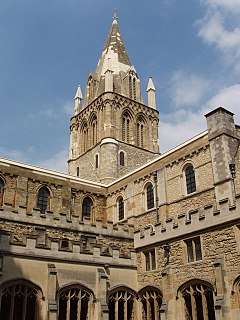 Crossing tower and spire from the cloisters | |
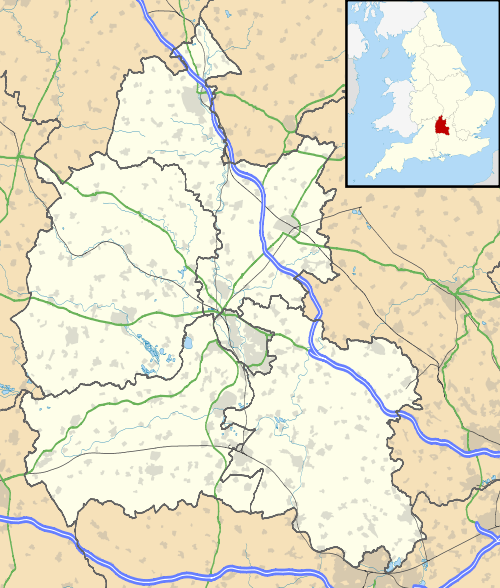 Christ Church Cathedral | |
| 51°45′00″N 1°15′17″W | |
| Location | Oxford, Oxfordshire |
| Country | United Kingdom |
| Denomination | Church of England |
| Previous denomination | Catholicism |
| Website | chch.ox.ac.uk/cathedral |
| Architecture | |
| Style | Romanesque, Gothic |
| Years built | 1160–1200 |
| Administration | |
| Diocese | Oxford (since 1546) |
| Province | Canterbury |
| Clergy | |
| Dean | Martyn Percy |
| Subdean | Edmund Newey |
| Precentor | Grant Bayliss (Diocesan) |
| Canon(s) | 4 theology professors (ex officio) |
| Archdeacon | Martin Gorick |
History
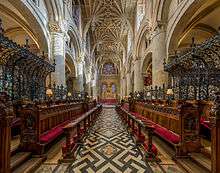

The cathedral was originally the church of St Frideswide's Priory. The site was historically presumed to be the location of the nunnery founded by St Frideswide, the patron saint of Oxford, and the shrine now in the Latin Chapel, originally containing relics translated at the rebuilding in 1180, was the focus of pilgrimage from at least the 12th until the early 16th century.[2]
In 1522, the priory was surrendered to Thomas Cardinal Wolsey, who had selected it as the site for his proposed college. However, in 1529 the foundation was taken over by Henry VIII. Work stopped, but in June 1532 the college was refounded by the King. In 1546, Henry VIII transferred to it the recently created See of Oxford from Osney. The cathedral has the name of Ecclesia Christi Cathedralis Oxoniensis, given to it by Henry VIII's foundation charter.
There has been a choir at the cathedral since 1526, when John Taverner was the organist and also master of the choristers. The statutes of Wolsey's original college, initially called Cardinal College, mentioned 16 choristers and 30 singing priests.
Christ Church Cathedral is one of the smallest cathedrals in the Church of England.[3]
The nave, choir, main tower and transepts are late Norman. There are architectural features ranging from Norman to the Perpendicular style and a large rose window of the ten-part (i.e. botanical) type.
Dean and Chapter
As of 28 January 2019:[4]
- Dean — Martyn Percy (since 4 October 2014 installation)
- Sub-Dean — Edmund Newey (since 3 August 2013 installation)[5]
- Diocesan Canon Precentor — Grant Bayliss (since 2 September 2017 installation)[6]
- Archdeacon of Oxford — Martin Gorick (since 4 May 2013 collation)
The university's four senior theology professors are also ex officio Canons Residentiary:
- Regius Professor of Divinity — Graham Ward[7] (since 2012)
- Lady Margaret Professor of Divinity — Carol Harrison (lay; since 27 April 2015 installation)[8]
- Regius Professor of Moral and Pastoral Theology — Nigel Biggar (since 6 October 2007 installation)[9]
- Regius Professor of Ecclesiastical History — Sarah Foot (since 6 October 2007 installation;[9] ordained 2017)[10]
Music
Organ
The organ is a 43-rank, four-manual and pedal instrument built in 1979 by Austrian firm Rieger Orgelbau.[11]
Organists
First among the notable organists of Christ Church Cathedral is the Renaissance composer John Taverner, who was appointed as the first organist by Wolsey in 1526. Other organists (and directors of the choir) have included Basil Harwood, Thomas Armstrong, W. H. Harris, Simon Preston, Francis Grier and Nicholas Cleobury. The post of organist is currently held by Steven Grahl. (As in many English cathedrals, the organist is also director of the choir and much of the organ playing is delegated to the sub-organist or organ scholar.)
Choirs
The main choir, the Christ Church Cathedral Choir, consists of 12 adults (6 professional "lay-clerks" and 6 student "academical clerks") and 16 choristers (boys aged 7 – 13), and is directed by Steven Grahl. They sing in university term time, at Christmas and Easter, and have an extensive touring and recording programme.
Former choristers include the composer William Walton.
The Cathedral Singers consists of volunteers and is currently directed by James Potter. They are usually in residence outside of term time when the choristers and academical clerks of the main choir are on holiday.
The college choir sings every 1–2 weeks in term time and is made up of current undergraduates and postgraduates from the college.
Since September 2019, the Cathedral has also had a choir for girls aged 7-14 called Frideswide Voices. The choristers are drawn from schools around Oxford, and sing evensong once a week. The choir is directed by Helen Smee.
Notable burials
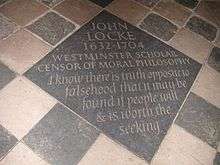
- John Bankes (1589–1644), English lawyer and politician
- Robert Burton, author The Anatomy of Melancholy
- George Berkeley, philosopher and Bishop of Cloyne (memorial in the nave)
- Sir Thomas Byron, Royalist officer in the First English Civil War
- John Fell, Bishop of Oxford
- Henry Gage (1593–1645) (buried in the Lucy Chapel, off the south transept)
- Henry Liddell, father of Alice Liddell
- John Locke, philosopher
- Lady Elizabeth Montacute (d. August 1354)[12]
- Edward Bouverie Pusey
- George Stewart, 9th Seigneur d'Aubigny, Cavalier
- Thomas Strong, Bishop of Oxford
- John Underhill (c.1545–1592), Bishop of Oxford
- John Urry, literary editor
- Peter Wyche, ambassador to the Ottoman Empire and member of the Privy Council
Gallery
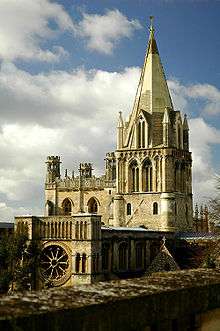 View of the cathedral
View of the cathedral The altar and vault
The altar and vault- Cloisters
- Chancel Vault
- Tomb of John de Nowers
- Stained glass window
See also
- List of cathedrals in the United Kingdom
- Christ Church, Oxford: more information on the College and the Cathedral
- Christ Church Cathedral School
- The Clerks of Christ Church
- Bishop of Oxford
- Diocese of Oxford
- Architecture of the medieval cathedrals of England
- List of Gothic Cathedrals in Europe
- English Gothic architecture
- Romanesque architecture
- Church of England
- ChristChurch Cathedral: in New Zealand that was inspired by the Oxford cathedral
References
- "Cathedral | Christ Church, Oxford University". Chch.ox.ac.uk. Archived from the original on 5 March 2016. Retrieved 4 March 2016.
- Levin, Carole (2013). The Heart and Stomach of a King. University of Pennsylvania Press. p. 20. ISBN 978 0 8122 2240 1.
- "Christ Church Cathedral – Miscellany". Web.archive.org. 6 December 2004. Archived from the original on 6 December 2004. Retrieved 4 March 2016.
- Christ Church, Oxford — Who's Who in the Cathedral Archived 17 January 2018 at the Wayback Machine (Accessed 28 January 2019)
- "News | Christ Church, Oxford University". Chch.ox.ac.uk. Archived from the original on 8 March 2016. Retrieved 4 March 2016.
- Christ Church, Oxford — Announcement of new Diocesan Canon Precentor Archived 17 January 2018 at the Wayback Machine (Accessed 16 January 2018)
- "Dean, Cathedral Chapter & Staff". www.chch.ox.ac.uk. Archived from the original on 29 January 2010. Retrieved 22 October 2014.
- "Canon Professor Carol Harrison – Christ Church, Oxford University". www.chch.ox.ac.uk. Archived from the original on 28 June 2018. Retrieved 28 June 2018.
- "News | Christ Church, Oxford University". Chch.ox.ac.uk. Archived from the original on 4 March 2016. Retrieved 4 March 2016.
- Diocese of Oxford — New Deacons Archived 16 January 2018 at the Wayback Machine (Accessed 16 January 2018)
- "The National Pipe Organ Register (NPOR) V2.11". Npor.org.uk. Retrieved 4 March 2016.
- McGee Morganstern, Anne (2000). "Gothic Tombs of Kinship in France, the Low Countries, and England". Penn State Press. p. 107. ISBN 978-0-2710-18-591 – via Google Books.
External links
| Wikimedia Commons has media related to Christ Church Cathedral, Oxford. |